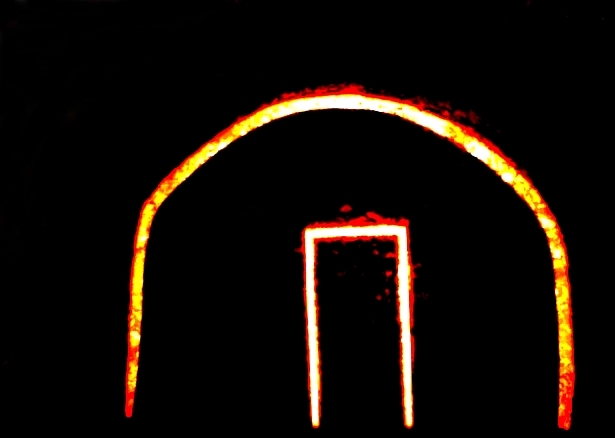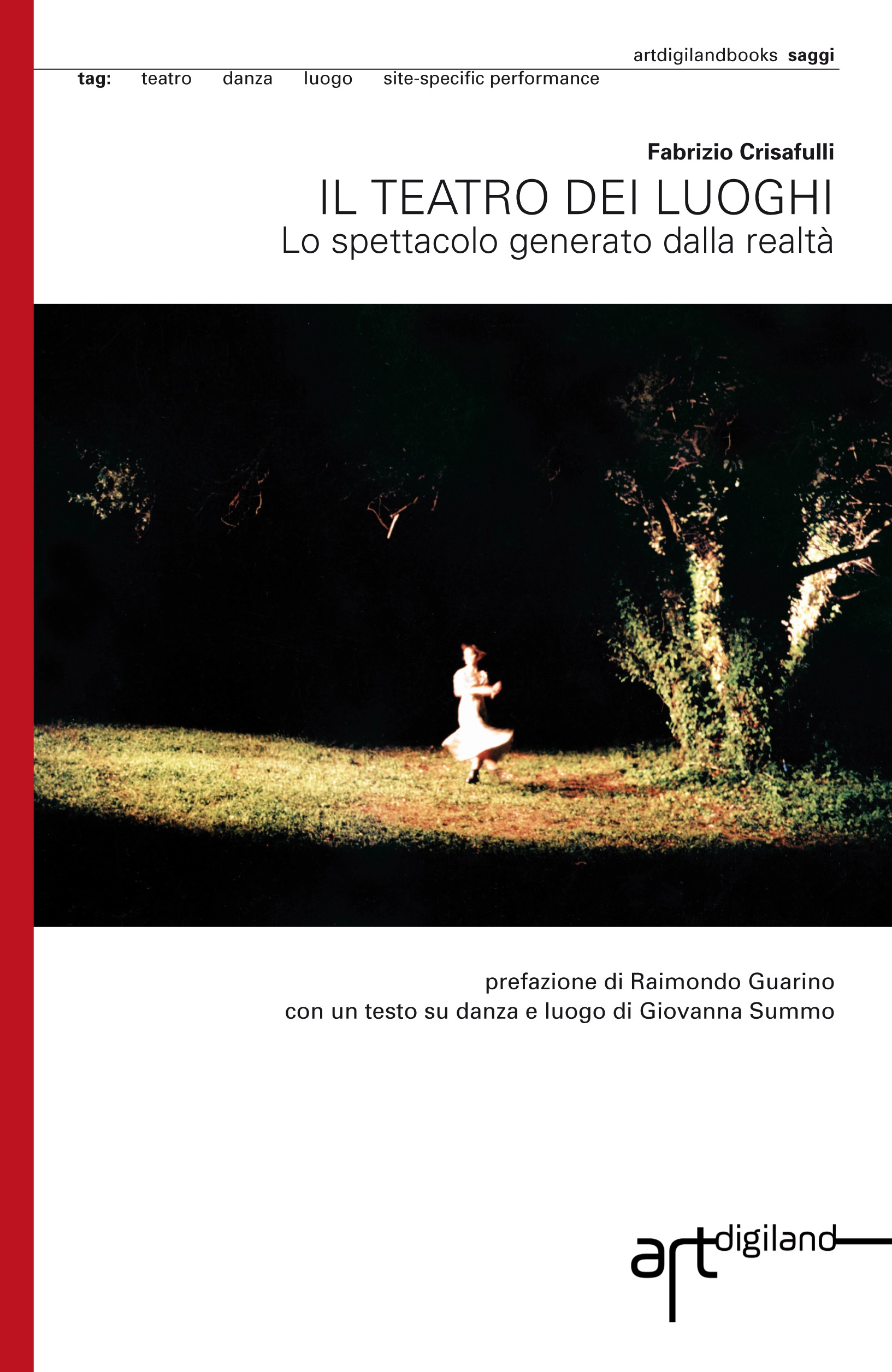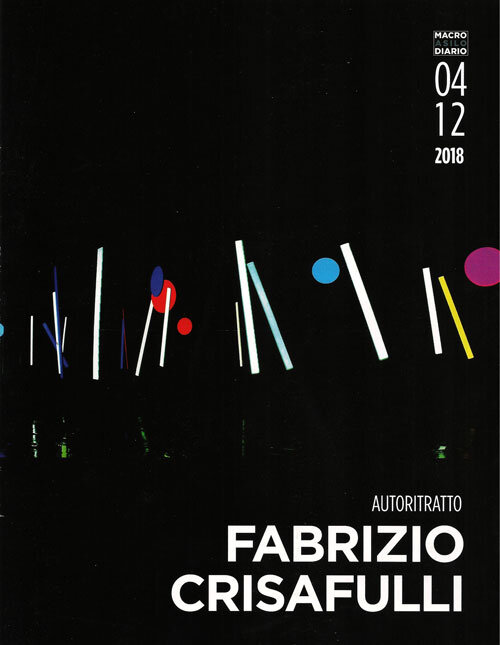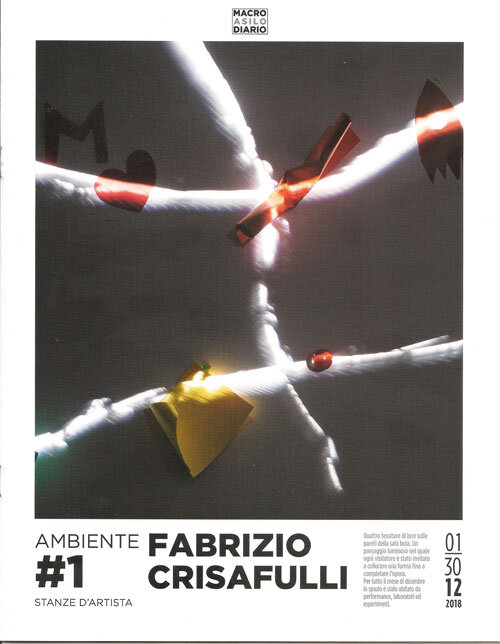BOOKS BY FABRIZIO CRISAFULLI
UN TEATRO APOCALITTICO
La ricerca teatrale di Giuliano Vasilicò negli anni Settanta
di Fabrizio Crisafulli
prefazione di Dacia Maraini
Artdigiland, Dublino, 2017
(pp. 296, illustrated, ITALIAN)
LUMIERE ACTIVE
Poétiques de la lumière dans le théâtre contemporain
par Fabrizio Crisafulli
préface de Anne Surgers
Artdigiland, Dublin, 2015
(pp. 282, illustré, Français)
ACTIVE LIGHT
Issues of Light in Contemporary Theatre
by Fabrizio Crisafulli
foreword by Dorita Hannah
afterword by Luca Farulli
Dublin: Artdigiland 2013
(pp. 270, illustrated, ENGLISH)
IL TEATRO DEI LUOGHI
Lo spettacolo generato dalla realtà
di Fabrizio Crisafulli
prefazione di Raimondo Guarino
Artdigiland, Dublino, 2015
(pp. 212, illustrato, ITALIANO)
LUCE ATTIVA
Questioni della luce nel teatro contemporaneo
di Fabrizio Crisafulli
prefazione di Luca Farulli
Titivillus, Corazzano (PI), 2007
(pp. 232, illustrato, ITALIANO)
Giuliano Vasilicò (1936-2015) was a protagonist of the Italian theatre of the seventies of the twentieth century, active in the context of the Roman underground scene. The book concerns his most profitable period: the one in which, after an extraordinary Hamlet (1971), he produced The 120 Days of Sodom (1972), which revealed the entire phenomenon of the Roman underground theatre in the Seventies, and Proust (1976 ): an almost unique case of effective transposition on stage of the human and poetic world of the French writer. Among the main contributions of Vasilicò's work to theatrical research are his peculiar way of constructing non-narrative dramaturgies and the idea of the “stage body”; of the performance intended as a compact organism, in which all the expressive elements have the same importance and incisiveness in determining the meaning of the work.
Giuliano Vasilicò (1936-2015) è stato un protagonista del teatro italiano degli anni Settanta del Novecento, attivo nel particolare contesto delle cosiddette “cantine romane”. Il libro riguarda il suo periodo più felice e proficuo: quello nel quale, dopo uno straordinario Amleto (1971), ha realizzato Le 120 giornate di Sodoma (1972), spettacolo-rivelazione dell’intero fenomeno delle “cantine romane” e Proust (1976): caso quasi unico di efficace trasposizione sulla scena del mondo umano e poetico dello scrittore francese. Tra i principali contributi del lavoro di Vasilicò vi sono la sua peculiare modalità di costruzione di drammaturgie non narrative e l’idea del corpo scenico; dello spettacolo inteso, cioè, come organismo compatto, nel quale tutti gli elementi espressivi hanno la stessa importanza ed incisività nel determinare il senso del lavoro.
Cet ouvrage revisite, du point de vue des poétiques de la lumière, quelques épisodes importants de la mise en scène théâtrale au XXe siècle, depuis les grands réformateurs des premières décennies jusqu’à divers artistes con- temporains tels que Josef Svoboda, Alwin Nikolais, Robert Wilson. Non pour proposer une histoire plus ou moins organique de la lumière au théâtre, mais pour tenter de préciser, relativement à son utilisation, certaines que- stions fondamentales. S’affranchissant des contextes étroits de la technique et de l’image dans lesquels on tend souvent à les enfermer, les probléma- tiques de la lumière sont examinées ici sous d’autres angles, ceux de la structure spatio-temporelle du spectacle, de la construction dramatique, de la création poétique, de l’action, du rapport avec le performer. Une partie de l’ouvrage est consacrée au travail théâtral de l’auteur. Elle documente le point de vue particulier sur lequel sa réflexion se fonde, point de vue suscité et enrichi par son expérience personnelle de metteur en scène.
Le titre “lumière active” se réfère directement à Adolphe Appia, qui à la fin du XIXe siècle fut parmi les premiers à aborder de manière précise – dans ses écrits comme dans ses créations – la question de la lumière en tant que question artistique du théâtre. Pour Appia la lumière active était la lumière scénique “proprement dite”: une lumière expressive et créatrice de formes, une lumière comme matière poétique et substance dramatique.
This book looks at various important events relating to the poetics of light in theatre production in the West in the twentieth century, from the great reformists at the beginning of the century to contemporary artists such as Josef Svoboda, Alwin Nikolais and Robert Wilson. The intention isn’t to outline a somewhat comprehensive history of stage lighting, instead it is an attempt to identify some basic issues concerning its use. Lighting issues are unshackled from the limited contexts of technique and image, where they often end up only to be relegated, and examined in the context of the performance’s space/time structure, poetic and dramatic construction, and the relationship with the performer. A section dedicated to the theatrical work of the author outlines the distinctive point of view behind the book, regarding the creative processes and the operational relationship with technique. The title Active Light is a direct reference to Adolphe Appia who, at the end of the nineteenth century, was one of the first to deal with the issue of light explicitly as an artistic issue in theatre, with his own writings and creations. As far as Appia was concerned lumière active was expressive light, creating shapes, forming poetic matter and dramatic substance.
The author analyses traits and modalities of that type of research he calls "theatre of places", almost than thirty years after its first formulation: a type of work in which the physical place and the set of relationships – material and immaterial – which constitute it are assumed as the matrix for creation. And clarifies how this kind of work is not only defined by the fact that it takes place outside the theatres, but by the very idea of "place" and the specific way in which the work relates to it, in any site it is carried out.
L’autore analizza le modalità di quel tipo di ricerca che chiama “teatro dei luoghi”, a quasi trent’anni dalla sua prima formulazione: un tipo di lavoro nel quale il luogo fisico e l’insieme delle relazioni – materiali e immateriali – che lo costituiscono vengono assunti come matrice della creazione. E chiarisce, tra l’altro, come il suo operare non sia definito tanto dal fatto di svolgersi fuori dagli edifici teatrali, ma dall’idea stessa di “luogo” e dal modo specifico in cui il lavoro si relaziona ad esso, in qualsiasi posto si svolga.
Il libro rilegge, dal punto di vista delle poetiche della luce, le più importanti vicende della messinscena teatrale occidentale del Novecento, dai grandi riformatori di inizio secolo fino ad artisti contemporanei quali Josef Svoboda, Alwin Nikolais, Robert Wilson. Non per delineare una storia in qualche misura organica della luce teatrale, ma per tentare di individuare, riguardo al suo uso, delle questioni di base. Le problematiche della luce vengono liberate dai contesti circoscritti della tecnica e dell’immagine nei quali restrittivamente finiscono spesso per venir relegate, ed indagate in ambiti come quelli della struttura spazio-temporale dello spettacolo, della costruzione drammatica, della creazione poetica, dell’azione, del rapporto con il performer. Una parte dedicata al lavoro teatrale dell’autore documenta il punto di vista peculiare che sta alla base del volume, interno ai processi creativi e al rapporto operativo con la tecnica.
Il titolo “luce attiva” è un riferimento diretto ad Adolphe Appia, che alla fine dell’Ottocento fu tra i primi ad affrontare in maniera precisa – con i propri scritti e con le proprie creazioni – la questione della luce quale questione artistica del teatro. Per Appia lumière active era la luce scenica “propriamente detta”: luce espressiva e creatrice di forme; luce come materia poetica e sostanza drammatica.
CRISAFULLI ON HIS OWN WORK
FABRIZIO CRISAFULLI: AUTORITRATTO
Macro Asilo Diario 04.12.2018, MACRO, Museum of Contemporary Art Rome, 2019 (ITALIAN)
FABRIZIO CRISAFULLI: AMBIENTE 1
Macro Asilo Diario 01/30.12.2018, MACRO, Museum of Contemporary Art Rome, 2019 (ITALIAN)







